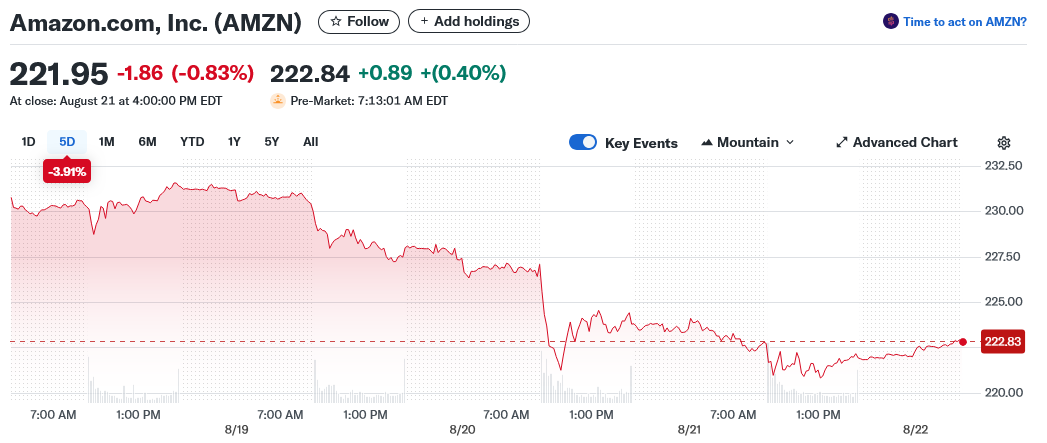TLDR
- Amazon stock fell 1.00% to $221.53 on August 21, 2025, as part of broader tech sector weakness driven by Federal Reserve rate concerns
- Shares have dropped nearly 5% this week, testing the key 50-day moving average support level around $226
- Company is aggressively expanding grocery delivery to 2,300 cities by 2025 and eliminated the $9.99 monthly delivery fee for Prime members
- Technical analysis shows bearish momentum with limited nearby support, raising concerns about further downside
- Analyst sentiment remains cautious despite positive developments in Amazon’s delivery expansion efforts
Amazon stock continued its recent slide, closing down 1.00% at $221.53 on Wednesday as technology shares faced fresh selling pressure. The decline reflects broader market concerns about potential Federal Reserve interest rate increases.
The e-commerce giant has struggled this week, dropping nearly 5% as investors reassess growth stock valuations. Recent commentary from Fed officials has reignited expectations for tighter monetary policy, weighing heavily on large-cap technology names.
Amazon’s troubles began in late July following its second-quarter earnings report. Despite beating Wall Street expectations, shares tumbled nearly $25 as cautious forward guidance disappointed investors.
The stock is now testing its 50-day simple moving average, a technical level that has provided support multiple times in recent months. This key threshold sits around $226, making it a critical battleground for bulls and bears.
Technical indicators paint a concerning picture for Amazon. The stochastic indicator continues trending lower, suggesting momentum remains bearish. Analysts note limited nearby support levels if the 50-day moving average fails to hold.
Should Amazon break below this support, the next major downside targets sit near $215 and $200. These levels could define the stock’s medium-term floor if selling pressure continues.

Grocery Delivery Expansion
Amazon is pushing aggressively into grocery delivery despite the stock’s recent weakness. The company announced plans to reach 2,300 cities by the end of 2025, with over 1,000 locations offering same-day delivery.
Management also eliminated the $9.99 monthly grocery delivery fee for Prime members. Orders above $25 now qualify for free same-day delivery, representing a major shift in the company’s delivery strategy.
These moves signal Amazon’s determination to tighten its grip on consumer spending. The expansion represents one of the most aggressive grocery rollouts in the company’s history.
However, investors appear unimpressed by the delivery news. Market participants seem focused on broader macroeconomic concerns rather than operational improvements.
Market Sentiment Remains Cautious
Analysts note that enthusiasm for Amazon’s growth initiatives has not translated into improved stock performance. Traders appear to be waiting for clearer earnings growth before re-rating the shares higher.
The broader technology sector faces headwinds as higher borrowing costs could dampen consumer spending. Business investment in tech may also slow if interest rates continue rising.
Volume patterns show average trading activity, suggesting the selloff lacks conviction from either buyers or sellers. This tepid participation could indicate uncertainty about Amazon’s near-term direction.
Price action remains largely event-driven in the current environment. The absence of clear technical structure means macroeconomic developments will likely drive short-term moves.
Federal Reserve policy remains the primary focus for growth stock investors. Any shift in central bank rhetoric could quickly change sentiment toward Amazon and similar names.
The company’s long-term growth prospects remain intact despite recent pressure. Amazon’s delivery network expansion and Prime member benefits could provide support once rate fears subside.
Current trading shows Amazon caught between ambitious growth plans and investor caution about monetary policy. The stock’s ability to hold the 50-day moving average may determine its near-term trajectory.
Amazon stock closed Thursday’s session at $222.00, down $1.81 or 0.81% from the previous day’s close.


